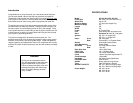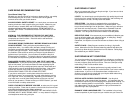
15
The saddle’s height can be adjusted by loosening the seat post binder
bolt located on the frame’s seat tube. To adjust the saddle height, twist
and pull the seat post up to the desired point and tighten the binder bolt,
making sure that the saddle’s nose is straight.
CAUSION: Do not raise the seat post above the maximum height
stamped on the seat post. If the maximum height is not marked or
not visible, make sure that at least 2-1/2” of the post remains inside
the seat tube. Failure to observe the maximum height may result in
serious injury, death, or damage to the bike.
WHEELS, TIRES & TUBES
It is important to check the condition of your wheels and tires frequently.
About 70% of the overall performance of the bike depends on the
condition of the wheels and tires.
Inspect the wheels for visible signs of corrosion, dents, broken spokes,
loose spokes, and wobbling. If a wheel wobbles during a ride or has gone
out of round, you may need to “true” or replace the wheel. Truing a wheel
is a complicated procedure and is best performed by experienced bicycle
technicians. If you observe a loose spoke, you can tighten it by using a
spoke nipple wrench. Spoke wrenches are available in different sizes and
types. The size of the wrench depends on the gauge of the spoke. You
can buy spokes from bicycle shops. Wheel axles may also become
loose over time. Make sure that the axle nuts binding the wheel to the
fork are tight. Also check for any movement of axle inside the hub body.
Axle bearings may need replacement or bearing cones may need
adjustment.
Components of front hub axle (bearings not shown)
Check your tires by observing any cuts, cracks on the side wall, air
pressure, and amount of wear on the thread. A worn-out tire is not safe
for riding and is more vulnerable to road hazards.
To prolong the life of the tires, keep the tire inflated with at least 25 PSI of
air when the bike is being stored or not used. It is best to keep the tires
off the ground in storage. If tires are left flat on the floor, the weight of the
bike will press the tire and tube and will cause cracks on the tire’s
sidewall.
To inflate the tire, read the recommended pressure on the sidewall
and do
not exceed the level indicated. Use a hand or foot pump suitable for
bicycles. CAUSION: Do not use a high-pressure air compressor
16
normally found at auto service stations as the high pressure may
cause a blow out.
Check the tire pressure using a pressure gauge specifically made for
bicycles. Automotive pressure gauges may not be suitable for bicycles.
When airing the tire, stop and make sure that the tire bead is properly
seated in the rim. If any part of the tire is not seated well, let some air out,
squeeze the sidewall while pressing the tire into the rim.
PEDALS
Your bicycle is equipped with a set of pedals. Pedals should spin freely
around the center spindle, which is attached to the crank arms. If pedals
fail to spin or the spindle is not tightly attached to the crank arm, do not
ride the bike until the pedal is secured to the crank arm.
CRANK SET AND BOTTOM BRACKET
The crank set and bottom bracket is the main driving component of the
bicycle. To check the crank for condition, have someone lift the rear end
of the bicycle. You should be able to crank the bike and spin the rear
wheel with one hand. If you are not able to crank using one hand or you
feel too much resistance, or if the crank wobbles inside the bottom
bracket, you may have a component
failure in your drive system. Have
the bicycle inspected at a bike shop.
CAUSION: Keep your hands and
fingers away from the spinning
wheel, the moving chain, or the
sprockets at all times to prevent
injury.
CHAIN AND CHAIN GUARD
The chain is the link between your crank set and the rear wheel. When
riding your bicycle, the chain is under constant pressure and tension. If
the chain is too loose, it may jump off the sprocket and break the link
between the crank set and rear wheel. If the chain is too tight, it may
warp the crank set, or come apart. A broken chain can become tangled
in the rear wheel and cause damage to the bike or serious injury. Have a
technician inspect the chain regularly.
The chain guard protects your legs and clothes from contact with moving
chain and sprocket. If the chain rubs against the chain guard or you hear
rattling, you can adjust the position by loosening the anchor bolts or
slightly bending the chain guard.
COASTER BRAKE
Your bicycle is equipped with a foot operated coaster brake. Coaster
brakes provide safe braking by using reverse force of the legs. Maximum
braking power is achieved in the 3 and 9 o’clock pedal positions. Coaster












